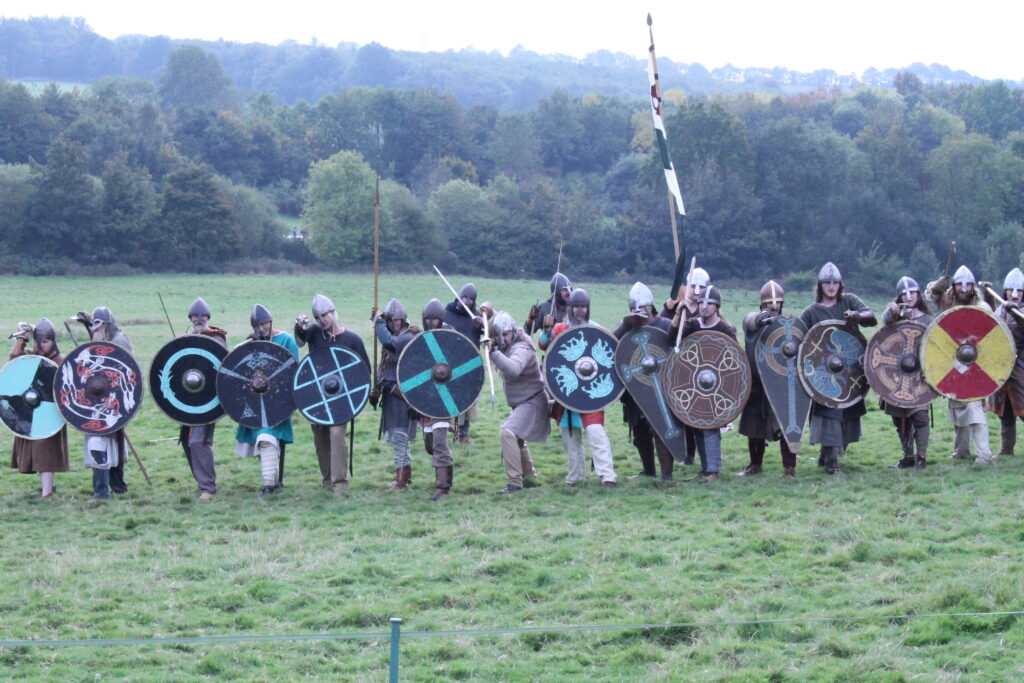
Driven into the marshes of the Somerset Levels by Guthrum’s surprise Christmas attack, Alfred had time to reflect on his strategy. On the Isle of Athelney, his household reduced to his immediate family and retainers, it must have seemed that everything was gone.
But Alfred, the most deeply Christian of early medieval kings, saw Biblical parallels in his reverse. Notably, David himself had had to flee from King Saul, taking refuge in the wilderness. From that wilderness, David had launched his guerilla campaign against Saul and that was what Alfred proceeded to do against Guthrum’s still unstable regime.
Success came at the Battle of Edington, where Alfred defeated Guthrum. But while Alfred imposed terms upon Guthrum and oversaw his baptism, standing as the Viking’s godfather, Alfred had been made painfully aware that his previous plans to deal with Norse attacks had been inadequate.
Alfred tackled the matter with his characteristic systematic intelligence. First came the question, ‘Why’? Why would God allow pagans to devastate the Christian kingdoms of the Anglo-Saxons? Alfred did not believe in a universe of chance. Things happened for a reason, and he applied to recent events the sort of self-analysis that the Jews applied to their own history in the Bible.
Alfred saw the English as a new Chosen people, set apart by God for his purposes. But while the Jews came to understand their history in terms of their falling away from the ancestral covenant they had made with God, Alfred came to a different conclusion with respect to his own people. It wasn’t so much that they had failed morally, but rather that they had failed by abandoning their previous commitment to learning and education. In the seventh and eighth centuries, Anglo-Saxon scholars such as Bede and Alcuin had been among the most learned men in the world. But by Alfred’s reign scholarship had fallen off so precipitously that the scribes for Canterbury Cathedral were unable to produce texts in intelligible Latin. It was this failure to nurture their patrimony of learning, Alfred believed, that had caused God to remove his protection from the Anglo-Saxon kingdoms.
Having established the cause, Alfred set out to remedy it. He started with himself. He had only learned to read and write English when he was 12. This was better than for many other people but it was still a source of embarrassment to Alfred. Nor could he read or write Latin, the language of scholarship. So, somewhere in his mid-30s, Alfred started to learn Latin, with the aim of achieving a high-enough standard that he would be able to translate Latin texts into English.
For Alfred had decided to embark upon a programme of education for his people so that they could recalim the mantle of scholars they had worn when Bede and Alcuin were alive. Alfred recruited to his court the most able clerics he could find, from Britain and abroad, men such as Asser, a Welshman, Plegemund, a Mercian, John from Saxony and Grimbald from France. Alfred’s court was becoming an international institution.
Recognising that most of his people had neither the time nor the opportunity to learn Latin, Alfred and his court scholars set about translating the books ‘most necessary for all men to know’ into English. These included the Dialogues and Pastoral Care of Gregory the Great, Bede’s Ecclesiastical History of the English People, the Consolation of Philosophy by Boethius and the first fifty Psalms. These works are full of spiritual, moral and practical wisdom, from the Consolation’s advice on how to deal with turns of fortune that leave you destitute – something Alfred himself was familiar with – to sound precepts for how a bishop should do his job in Pastoral Care.
Alfred sent a copy of Pastoral Care to every bishopric in the country. He was shrewd enough to guess that Gregory’s pastoral advice might best be gold-plated with an earthly gift, so included with each book a beautiful and valuable text pointer. To ensure that the knowledge in these books reached beyond the episcopacy, Alfred established a court school to teach not only his own children but also the children of the nobility and even many among the common born. To recover from the ravages of the Vikings, Alfred fostered a thorough going cultural renewal.
That Alfred, while burdened with all the duties of a king, should still find time in his day to translate Latin texts into English for the good of his people marks him out as truly exceptional among monarchs. There have been many great warrior kings, there have even been a few scholar kings, but Alfred is pretty well unique in being both.








